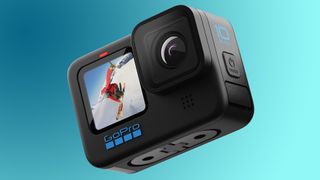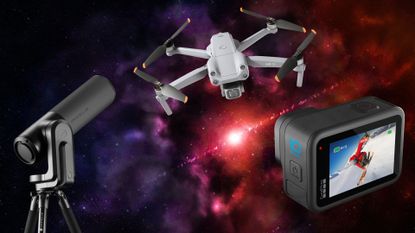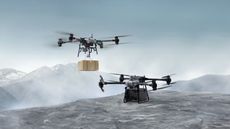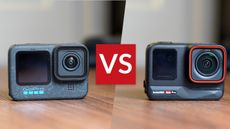The main issue in the world of outdoor tech this past year has not just been the excitement of products themselves, but maintaining a sufficient amount of stock in the supply chain, as well as having all the component parts in the right place at the right time to construct the devices in the first place. Even the world’s biggest e-tailer has more often than not displayed the message 'stock expected soon'.
While innovation's confident strut may have temporarily slowed, it's not stopped altogether though, and products have made it out of the pipeline and are continuing to do so.
So, with the state of the world being one of flux, we’re focusing on three specific genres of device. Whether you're interested in how the best action camera, the best drone or the best telescope will develop over the next few years, we're whipping out our crystal ball and asking: what's next for outdoor tech?
- Get airborne with the best beginner drone
- Find the best budget action camera
- How to choose your first telescope
Action cameras: better sensors
As a means of capturing daring rough and tough escapades that would leave regular cameras or smartphones crying digital tears, helmet or handlebar-mounted action cameras at consumer prices have been available for a long while now. And they've become increasingly compact, with ever higher resolutions and jam-packed feature sets, to the point where it seems doubtful they could be improved much further.
So today we have the must-haves of 4K video at up to 60fps, on-board multiple axis image stabilisation, shock-proofing, water proofing, time-lapse and slow-mo video features, HDR photography, voice activated recording and more. For those indulging in daring pursuits that require hands to be kept free, voice activation feels like a feature well worth having that will continue into the future as a feature more convenient than a remote or touchscreen, while battery life and with it the ability to shoot more images or record more video is always something manufacturers are working on, and looking to extend.

High quality sensors that can deliver even more detail while not necessitating physically larger housing are obviously another area for continuous development – with size, shape and weight of the device likewise being crucially important when it comes to action cameras, as is compatibility with the various common mounts and grips on the market. For the time being, though, we reckon the GoPro HERO10 Black is the best action camera you can buy right now. Find out why in our GoPro HERO 10 Black review.
Drones: built-in footage editing
The good news here is that the majority of today’s drones don’t require their pilot to endlessly fiddle with their controller, or have taken a Master's degree in physics. They pretty much fly themselves, returning to their take off point when necessary and can lock onto and follow subjects autonomously, without further input from the pilot, while sensing and avoiding objects in their path.
Like most digital cameras and phones these days, today’s drones can capture 4K resolution video at 30 or even 60 frames per second, while 1-inch sensors in the case of the common Sony chip and the DJI AIR 2S (read more about it in our DJI Air 2S review), are a match for dedicated cameras and camcorders.

Footage from today’s drones can be streamed straight to a smartphone, while the smartphone can be paired with and used as our controller if desired. Drones themselves have also become smaller and lighter, and at the same time more feature-packed, as technology has improved.
Since we already have palm-sized drones and devices that collapse into more compact configurations for easier transportation when not in use, we may not actually want them to go much smaller in the near future, but it’s a fair bet that image quality and capture rate will continue to improve, while multi-axis gimbals will deliver ever smoother footage, despite the ever-smaller form factors drone sensors and lenses are being shoehorned into.
In the future, more drones will also be able to not only shoot but also self-edit footage in-camera for us, saving valuable time when all we want to do is instantly share the fruits of our drone’s labours online.
Telescopes: app controlled smart scopes
Today’s telescopes have been designed to help us find heavenly bodies faster and more accurately than ever, by being capable of automatically tracking constellations of interest and working in tandem with the latest smartphone apps plus on-board Wi-Fi to make sure there are always stars in our eyes.
Of course how far and deep into space we’re able to see not only depends on the technology available to us, but also the size of the scope itself and our available budget when buying. Expect remote control handsets for more upmarket models to become a thing of the past, as wireless connectivity becomes more reliable than it already is and smartphone apps are updated more regularly.

What could be simpler than holding our linked smart device up to the night sky, tapping the screen and having our telescope zoom in close on the region, while our device’s screen displays information about the stars and planets within viewable distance? Sounds like clever stuff, right? Really high-end telescopes, such as the super-smart Unistellar Evscope Equinox (see our Unistellar eVscope eQuinox smart telescope review for all the glorious details) have pushed boundaries further and done away with the once-essential feature of a built-in eyepiece, reasoning that the user’s smartphone or tablet, combined with the clever image processing, will take its place.
In short, as long as we’re prepared to stump up the cash, expect telescopes to become ever easier to use and more reliable in terms of accuracy, straight off the bat.











